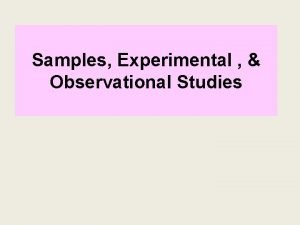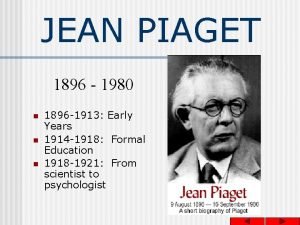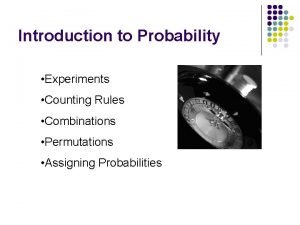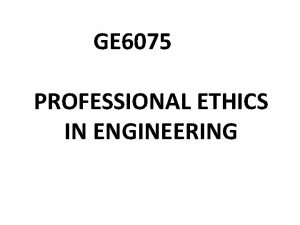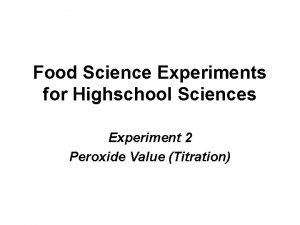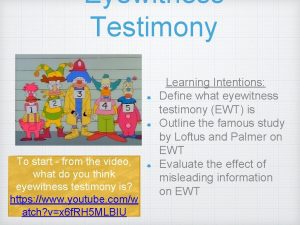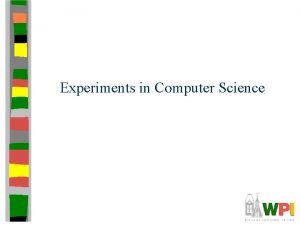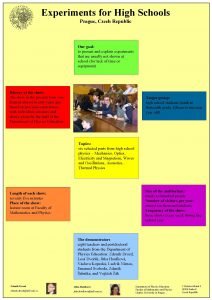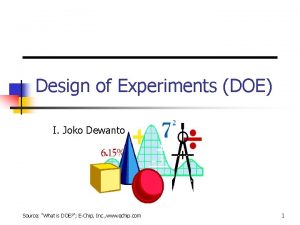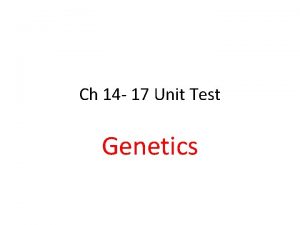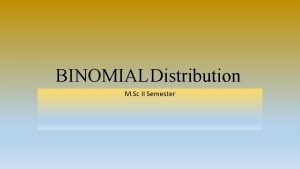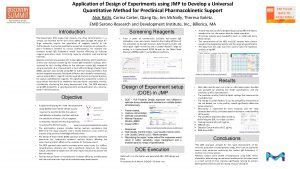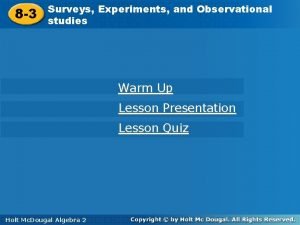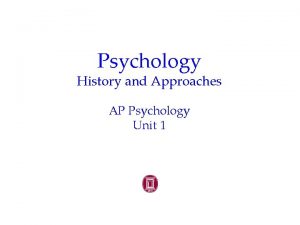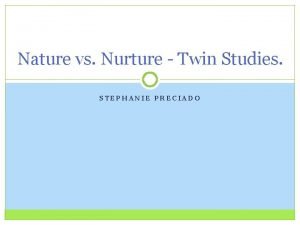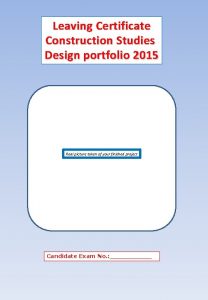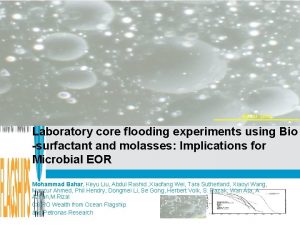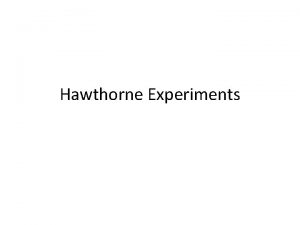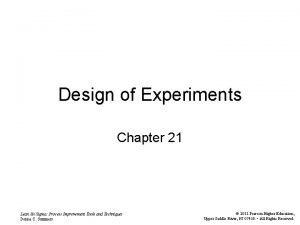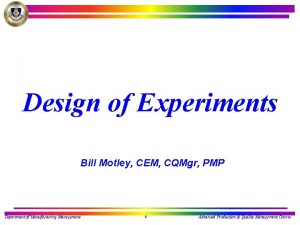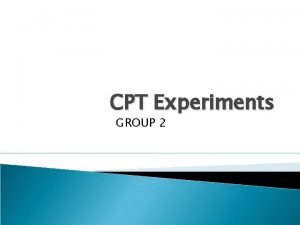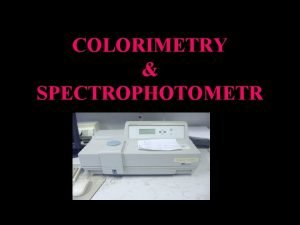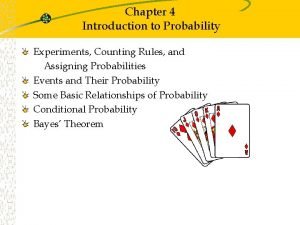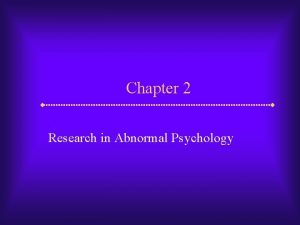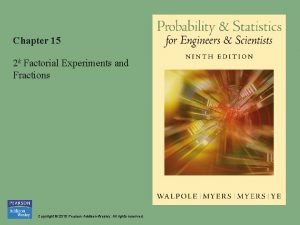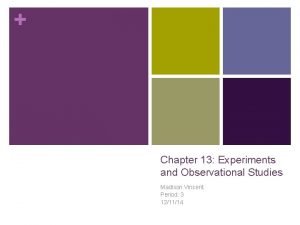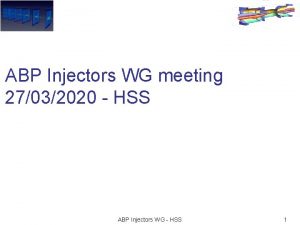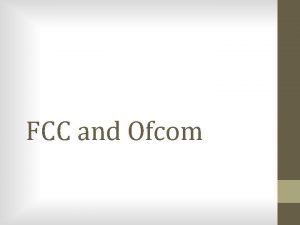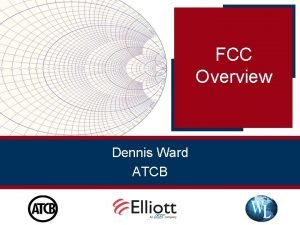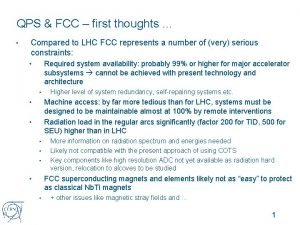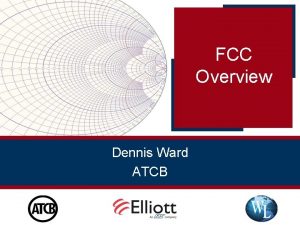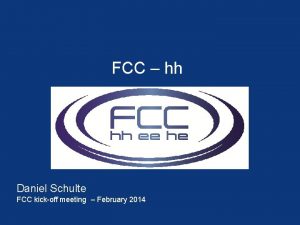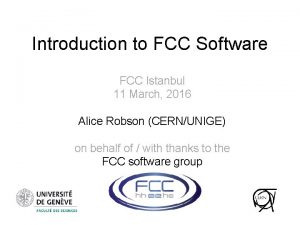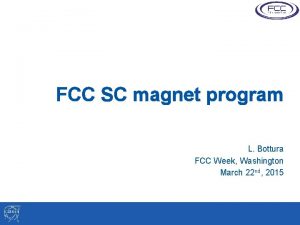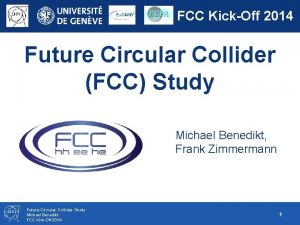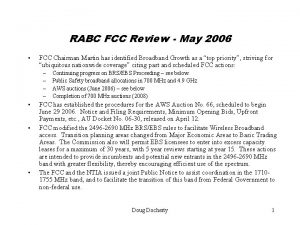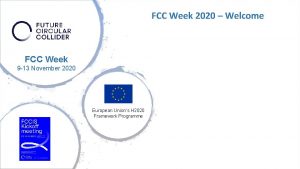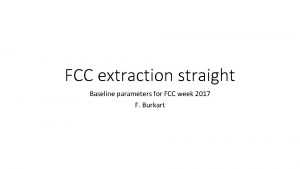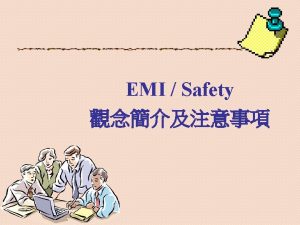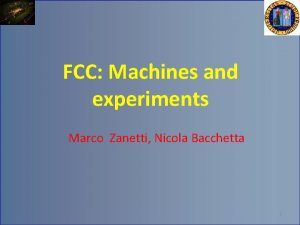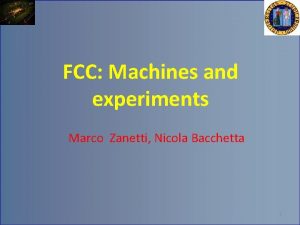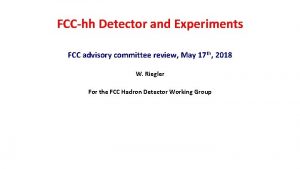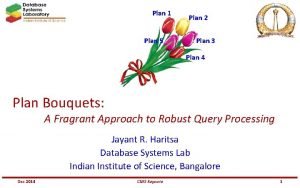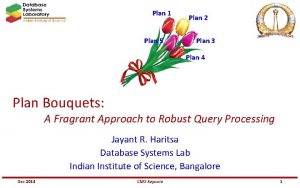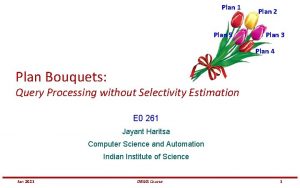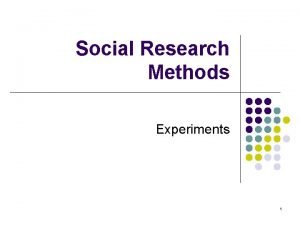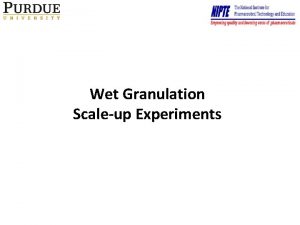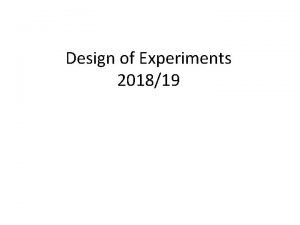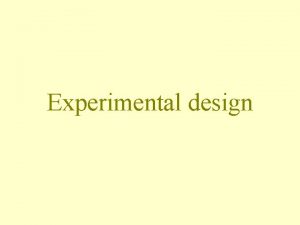FCC injectors plan FCC WG on experiments with


































- Slides: 34

FCC – injectors ‘plan’ FCC WG on experiments with the CERN injectors 29/9/14 B. Goddard, W. Herr for the FHI WG

Outline • Initial assumptions – Requirements, pre-injector performance, constraints • HEB tunnel options and features – SPS – LHC – FHC • • Injector complex baseline assumptions Comparison of idealised FT performance reach High luminosity IP in HEB performance reach Potential issues

Basic assumptions for FCC injectors • Maximise CERN facility reuse – Add High Energy Booster (HEB) to present LHC injector complex – Not considering an “SPL/PS 2 -like” option to rebuild full complex – No new ‘few MW proton driver’ • Take HL-LHC injector chain output for granted – 2 e 11 p+/bunch in 2 mm exy at 25 ns • FHC: 100 km collider length, 50 Te. V/beam – 1 e 11 p+ per bunch, 25 ns spacing, need to fill ~11’ 000 bunches • Evaluate HEB designs with 2 -in-1 magnets – May not be realistic for all options – Only one ring assumed for FT beams! • Collider filling times with present injector complex cycle times (but 4 ->8 PS batches in SPS)

FHC injection considerations • Minimum FCC filling time (on paper) should be of order of 10 minutes – Aim to keep this ‘in the shadow’ of 50 Te. V collider cycle time – To note: on paper present LHC could fill both rings in under 10 minutes • Injection energy considered as 3. 3 Te. V – Gives same field ratio (collision/injection) as present LHC – Working hypothesis for injectors and collider studies – Lower may severely penalise FCC (magnet aperture, instabilities, …) – Possibility that this energy might increase, if found advantageous for 50 Te. V collider design

An FHC injector chain LINAC 4 PSB 0. 16 – 2 Ge. V (x 13) 0 -160 Me. V (H-) PS 2 – 26 Ge. V (x 13) SPS 26 – 450 Ge. V (x 17) HEB 0. 450 – 3. 3 Te. V (x 7) Energy swing in HEB is low: 5 Te. V and x 11 would fit better! To FHC 3. 3 - 50 Te. V (x 15)

HEB magnet technology options

Existing tunnels and lengths CERN already has a good selection of ‘available’ tunnels, so the first HEB studies are based on these!

Options… • Plenty of them…. • Starting point for injectors assumes re-use of existing LHC chain, up to and including SPS – New HEB: should reach ≥ 3. 3 Te. V and fill FHC in ~10 minutes • Initial options for evaluation: – 7 km SC machine in SPS: • Very high field 18 T Nb 3 Sn (to reach ~4 Te. V) – 27 km existing LHC reuse • Ramp rate to increase by as much as possible: x 5 target • New 2 -quadrant higher voltage powering, new QPS, remove low-b, … • Decommissioning of highly activated zones to study. . . or replace LHC with new ‘low-cost’ machine…. – 100 km NC/SF machine • 30 -60 km of 2 -in-1 iron dipole magnets, at least 1000 quadrupoles

Specific topics for FHI study • Minimum injection energy in FHC – 1. 8 Te. V opens other options for HEB. . . but more likely to be >3. 3 Te. V • Feasibility of HEB in SPS tunnel (if 2 Te. V FCC injection possible) – Integration, ramp rate, 1 or 2 apertures… • Feasibility of LHC reuse for HEB – – – Lattice design for simplified 3. 3 Te. V synchrotron Key question of ramping dipole at ~50 A/s. Studies, tests? ? Availability (how often were there 4 consecutive LHC ramps? ) Decommissioning feasibility Civil engineering aspects • Feasibility of HEB in 100 km tunnel – Beam dynamics at 450 Ge. V injection energy (space charge, impedance, IBS, …) – Basic lattice needed • Preliminary cost scaling for key systems for all options • Beam transfer, machine protection (both of these get difficult!)

HEB options – SPS tunnel: SC low-field can reach 1. 1 Te. V, but 3. 3 Te. V is tough

HEB options – LHC tunnel: wide range of possibilities – including reuse of LHC

HEB options – FCC collider tunnel FCC tunnel: 2. 0/2. 5 T NC/SF with 0. 35/0. 28 filling-factor

Baseline option? • Reuse of existing LHC machine has strong “naturalness” arguments in favour, if it is technically feasible and cost competitive • So presently assumed to be baseline – other versions are options for study …. so, a digression on reuse of LHC….

Constraints for LHC reuse • For RF reasons, need to keep both rings the same length – Implies minimum of 2 crossings, at opposite IPs • Should avoid decommissioning and repurposing IPs 3, 6 and 7 – Radiation • Need to keep injections in IP 2 and IP 8 – Otherwise major extra transfer lines to build • Beam extraction to collider ideally in IP 1 (IP 5 also possible) • No crossing in IP with beam extraction

Reusing LHC: From this…

To this…? Empty? RF/Xing Dump P 5 P 4 Cleaning P 6 P 2 RF: need to keep ring 1 and ring 2 same length! Min. of 2 crossings Cleaning P 7 P 3 P 8 P 1 Injection B 2 Extraction To FCC

Changes per IP (1 -4) • IP 1: extraction to collider: – removal of low-beta insertion and ATLAS, civil engineering for junctions to new TLs to collider, new extraction system – assume for now same optics and layout as present IP 6 • IP 2: injection of B 1 (no crossing) – removal of low-beta and ALICE – modification of injection system to inject into INNER ring (presently to outer!) • IP 3: collimation – unchanged • IP 4: RF and new crossing – Addition of D 2 magnets, plus required matching quadrupoles for crossing (not at IP…)

Changes per IR (5 -8) • IP 5: FODO transport, no crossing – removal of low-beta and CMS, construction of floor through CMS cavern, installation of FODO quads – Possible location for FT extraction system • IP 6: beam dump – unchanged • IP 7: collimation – unchanged • IP 8: Injection beam 2 and crossing – removal/modification of low-beta and LHCb

Optics features in IP 2 • Injection in IP 2 to INSIDE ring • Need to shift injection septa and kickers downstream by about 16 m, and Q 5 • Optics implications seem manageable

Optics features in IP 4 • • Horizontal crossing needs pair of MBRB D 4 magnets Vertical separation needs 2 MCBXV or MCBCV No major changes to optics at RF cavities Dispersion can be matched back down to a few cm for both beams

FT extraction insertion in LHC • Depends on where transfer to FCC takes place, but would be either P 1 or P 5 • Not yet looked at any details of extraction system requirements or possible layout • Likely to be not particularly straightforward to design conceptually…. • Crystal extraction to be taken seriously as an option – discussing with W. Scandale and Collimation team about studies and SPS/LHC MD

FT Po. T estimates • Simple methodology to compare options…. • Limit peak power on targets to 2. 0 MW – Maybe slightly pessimistic at this stage (or maybe not!) • • • Stored energy in beam given by FCC filling constraints Adjust spill lengths to give 2. 0 MW power Subtract FCC filling time 80% efficiency for FT physics Total cycle length and protons per spill then give maximum Po. T per year (if no other limitations) – Reality will be worse

Po. T from cycle length etc. HEB@ Beam energy Total intensity Ramp up/down time Flat top time HEB filling time Fraction of time filling FCC (2 per day) Operation days per year FT efficiency FT cycles per year FT Po. T per year FT average power Peak power on target during spill Te. V p+ s s min MW MW SPS tunnel 16 T 3. 3 7. 2 E+13 1290 23 616 0. 85 250 0. 8 1908 1 E+17 0. 004 2. 0 LHC reuse FCC Tunnel 5 x faster SF 3. 3 2. 6 E+14 1. 1 E+15 239 3 82 345 25 20 0. 17 0. 05 250 0. 8 10828 46994 3 E+18 2 E+19 0. 1 1. 5 2. 0 so e 18 p+/year at 3. 3 Te. V might be envisaged, from these considerations…. (note that 2 e 19 p+ for FCC tunnel option is limited by what SPS can produce!)

Extraction of FT beams from HEB • Fast extraction works, but slow extraction is assumed essential… – For experiments (digesting ~e 14 p+ in ~100 us…? ) – For targets (20 -700 MJ on target in ~100 us…? ) • Will be technologically “challenging” for a machine at 3. 3 Te. V!

Possible limitations - i • Extraction system for 3. 3 Te. V – SPS works at 450 Ge. V – Space in lattice is ~100 m – Beam losses will be 10 -20 k. W in extraction region • Equipment performance, activation, radiation damage – Limiting elements are • Thin electrostatic septa (E field 100 k. V/cm, 50 um diameter wires, 15 m active septum length) • Thin magnetic septa (5 mm thick, 7. 5 k. A current)

Possible limitations - ii • Distributed beam losses in SC magnet system – For re-use of present LHC, would appear *very* challenging to incorporate an insertion with 1% beamloss, while maintaining sufficient cleaning efficiency elsewhere – For HEB@FCC tunnel, even if HEB is NC or SF, would be sharing a tunnel with 16 -20 T dipoles…. • Maybe need separate parallel extraction straight for HEB for some 2 -10 km, for extraction plus beam cleaning…. cost, layout, … – For HEB@SPS, looks even more difficult to manage extraction losses, as the existing LSS are only 120 m long

Other challenges… • 3. 3 Te. V beam transfer for slow-extracted beams – Losses may make SC magnets difficult, but huge bending radius with 2 T NC magnets! • Targetry for 3. 3 Te. V, 2 MW beams – 3. 3 Te. V beam likely to pose different difficulties compared to typical ~Ge. V energy of spallation sources • Shielding and experimental area design • Secondary beamlines • Very long spills… – Spill quality – Resonance and ripple control – POWER CONSUMPTION (HEB running most of time at top energy!) – Crystal extraction studies to look at

High luminosity IP in injector?

Performance? • ~2800 colliding bunches – – 2. 2 e 11 p+/bunch 2. 5 um emittance 3. 3 Te. V Assume geometric reduction of 0. 9 (with crab cavities) • Aim for initial luminosity of 1 e 35 Hz/cm 2 – Needs beta* of ~15 cm – 230 events per crossing • 200 days, H=0. 25, 40% of time filling 50 Te. V collider: 250 fb-1 – 7 Te. V and 15 cm beta* would increase these numbers: L=2 e 35 Hz/cm 2, 480 events/crossing, 520 fb-1/y

Possible limitations • Where to start…. ? • Probably a large perturbation from the 50 Te. V collider operation (60% probably optimistic) • Modifying LHC as HEB may limit energy reach to 3. 3 Te. V • Faster ramping may require redesign/removal of many circuits needed for collider operation • If ‘high intensity’ FT beams are needed, this is probably mutually exclusive, or at least will reduce integrated luminosity by ~x 2 • Costs: operating, manpower, maintenance, …

Summary • Injectors for FCC ‘plan’ on adding HEB to existing CERN complex • HEB is assumed to fill collider at 3. 3 Te. V • Baseline for FCC study is upgraded LHC (x 5 faster ramp, new layout, other mods). 4 ramps to fill collider • Other options are SPS (looks very unlikely), a NC machine in the collider tunnel (looks very long), or replacing LHC with new 5 T machine (looks very profligate).

Summary • For 3300 FT beams, Oe 18 Po. T/year at 3. 3 Te. V ‘could be envisaged’ from time-sharing arguments, depending on which HEB option • Need to look seriously at feasibility of 3. 3 Te. V slow extraction from these HEB machines – – Extraction concept, layout, technology Losses, collimation, quenches, collider cross-talk Spill quality and control Targets, beam transport, experimental area • For single high luminosity IP, 3. 3 Te. V could reach maybe 250 fb-1 per year, with 230 events per crossing at 25 ns – Serious concerns about compatibility with ‘injector’ operation – What experiments would be better at the HEB, instead of the FCC collider?

Input needed • Is there a use for a single high luminosity IP in 3. 3 Te. V HEB? – If so, what would be: • Beam energy (default 3. 3 Te. V) • Integrated luminosity per year (probably <250 fb-1? ) • Maximum pileup (around 230 events/crossing) • Is there a use for 3. 3 Te. V FT beams for physics? – If so, what would be: • Beam energy (default 3. 3 Te. V) • Po. T per year (maximum seems to be <3 e 18) • Spill length (few minutes? ) – Same questions for test beams!

fin
 Mixrite injector manual
Mixrite injector manual Split/splitless injector
Split/splitless injector Premco injectors
Premco injectors Ion injectors
Ion injectors![[http://earthobservatory.nasa.gov/experiments/biome/] [http://earthobservatory.nasa.gov/experiments/biome/]](data:image/svg+xml,%3Csvg%20xmlns=%22http://www.w3.org/2000/svg%22%20viewBox=%220%200%20200%20200%22%3E%3C/svg%3E) [http://earthobservatory.nasa.gov/experiments/biome/]
[http://earthobservatory.nasa.gov/experiments/biome/] M&m experiments with scientific method
M&m experiments with scientific method Observational study examples statistics
Observational study examples statistics Jean piaget (1896-1980)
Jean piaget (1896-1980) Counting rule for multiple-step experiment
Counting rule for multiple-step experiment Engineering projects vs standard experiments
Engineering projects vs standard experiments Science experiments for highschool
Science experiments for highschool Eyewitness testimony video experiments
Eyewitness testimony video experiments Computer science experiments
Computer science experiments Czech experiments
Czech experiments 1928 frederick griffith
1928 frederick griffith Design of experiments doe
Design of experiments doe In his transformation experiments what did griffith observe
In his transformation experiments what did griffith observe Which three criteria do binomial experiments meet?
Which three criteria do binomial experiments meet? Jmp doe analysis
Jmp doe analysis Surveys experiments and observational studies 8-3 answers
Surveys experiments and observational studies 8-3 answers Examples of binomial experiments
Examples of binomial experiments Computer architecture lab experiments
Computer architecture lab experiments G stanley hall ap psychology
G stanley hall ap psychology Barbara herbert and daphne goodship
Barbara herbert and daphne goodship Construction studies project
Construction studies project Core flooding experiment
Core flooding experiment Relay assembly experiment
Relay assembly experiment Full factorial design
Full factorial design Design of experiments pmp example
Design of experiments pmp example Experiments in goodness
Experiments in goodness Spectrophotometr
Spectrophotometr Counting rule for multiple-step experiments
Counting rule for multiple-step experiments Abnormal psychology experiments
Abnormal psychology experiments 2k factorial experiments and fractions
2k factorial experiments and fractions Chapter 13 experiments and observational studies
Chapter 13 experiments and observational studies
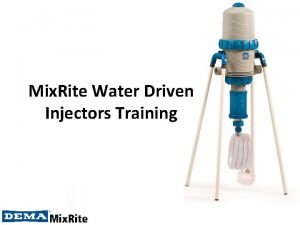
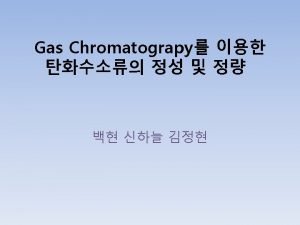
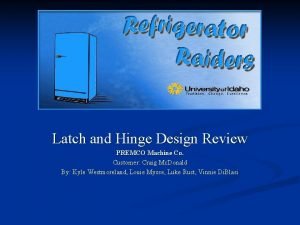
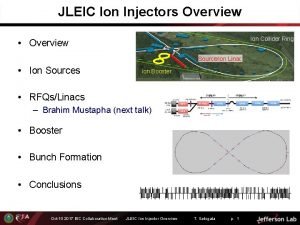
![[http://earthobservatory.nasa.gov/experiments/biome/] [http://earthobservatory.nasa.gov/experiments/biome/]](https://slidetodoc.com/wp-content/uploads/2020/11/1537165_35fb5ecc588217ed14768e866616d64b-300x169.jpg)

